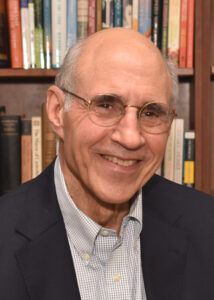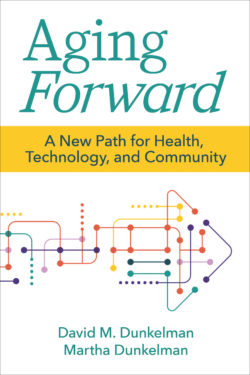
Whether it’s a fear of nursing homes, worry about money running out, or the political crisis of the future of Medicaid and Medicare, the uncertainty of aging is on the minds of many Americans. Author of Aging Forward: A New Path for Health, Technology, and Community, David Dunkelman talks us through why we all need to be thinking about this, and how the solutions to our concerns are all around us just waiting to be applied.
America now has more older adults than ever before, and it’s a growing concern how society is going to handle care for this many people. How critical is this issue, and why is it important?
Aging is America’s largest economic, socio-demographic challenge. Soon it will account for 50% of federal spending (for context, that is 2 ½ times the size of the defense budget). The number of older adults is a major driver of the student debt crisis, the immigration challenge, lower birth rates, and women’s roles.
Our antiquated care delivery system for aging dramatically exacerbates these issues and expenses.
In your book, you talk about the Industrial Age model of care, and how America has now outgrown it. Can you give some examples of what that model of care looks like and why it’s not working anymore?
Our Industrial Age healthcare system followed the model of mass production seen in factories, which set up assembly lines to deliver inexpensive and standardized products. In a similar manner, we collected medications, doctors, nurses, equipment, and goods in hospitals to mass-produce care for infectious and acute diseases such as diphtheria and cholera. We won those battles, but as a result more people live to older age, accumulating multiple chronic conditions (heart and lung disease, stroke, arthritis, Alzheimer’s, etc.). Since the highly specialized hospital was designed to cure specific acute diseases, it is unable to care for the web of complex and interacting conditions of chronic care.
What about nursing homes that are built specifically for the care of elderly and disabled people?
Nursing homes were also traditionally built on platforms similar to hospitals, following the standards of mass production economics. At the time there were only a few things that we could do for older residents, besides keeping them fed, toileted, and somewhat occupied. There were few therapies or medications. As with hospitals, when people accumulated multiple chronic conditions, the nursing home had difficulty tailoring individualized care in a facility designed for one-size-fits-all. Nursing homes now narrow their range of services. They are generally becoming more specialized, more medicalized, and focused on short-term—not long-term—care. Ironically, in an era of increasing chronic disease, our traditional aging facilities are turning away from long-term, chronic care.
How do chronic conditions come into play with this topic?
Until recently, the perception of growing old did not take into account chronic disease. The general assumption was that people would live longer and stay well, until about age 85 when everything would fall apart all at once—at which point older people would fit neatly into the specialized mini-industries of hospitals, nursing homes, assisted living, and homecare, each with its entirely separate regulations and workforce. We did not anticipate that chronic diseases would accumulate and that the care needs among older people would present an almost infinite variety of combinations. As an older person accumulates multiple conditions, even while there are an increasing number of existing interventions for them, it has become extremely challenging to coordinate care across the various specialties.
How can digital technology revolutionize how and where we care for older adults?
The efficiency and flexibility of digitization have replaced mass-produced, traditional Industrial Age approaches in most every other major American industry: retail, transportation, hotels, banking, and entertainment. These changes are coming to our care delivery system for aging. Traditional homecare services have often been inadequate for isolated, vulnerable older people. It’s difficult to effectively monitor the ongoing, dynamic changes in the whole person, or to understand and anticipate his or her needs.
Now, with technology and digital interventions, people should be able to remain in their homes as they age while still receiving the level of care that they need. Devices such as digital scales, phones, wearables, cameras, and many others can be tailored to an individual person and environment. Systems can collect and process information, which care managers can use to suggest interventions and monitor their progress. The home in the community can function as a node in a network, connecting the person to coordinated teams of specialists. We already use networks like this in our cars with GPS programs that enable us to make informed decisions in real time while maintaining our privacy. It’s time to apply these solutions that work so well in other industries to aging.
Most people would say they want to live at home for as long as possible, and many dread the idea of having to move into a nursing home. Is it really feasible that so many older adults can remain in their own homes as they age?
Not only is it feasible that so many people will remain in their homes, but for most there will be no alternative. Fifty percent of Baby Boomers have minimal assets, and about 75% have insufficient money for adequate care (as we have known it) in their frail years. Community is not only where frail older people wish to be, but it is where they will be. The only question is how to coordinate and deliver into community homes the extraordinary toolbox of interventions, programs, and services that now exists for living an engaged, healthy life even in the frailty of older age. Many interventions, often from different dimensions of life, are interchangeable. What is desirable are combinations that are least invasive, least expensive, and most consistent with the person’s previous way of living. A goal is to replace medical with social ones that are less taxing and expensive for everyone.
But in the antiquated Industrial Age framework that still dominates aging services in the community, each program, each specialist, each approach is almost sealed off from the others. It is challenging, if not treacherous and frightening, to coordinate interventions for an older person with accumulating and overlapping chronic conditions. But making all this possible is around the corner thanks to digital technology. And, in addition to being able to coordinate interventions, the technology allows for endless possibilities for prevention of illness, such as coordinating meal deliveries, rides to social activities, and countless other “wraparound” services that support good health without necessarily being medical interventions.
What would you say to people who think this situation is insurmountable and that the solutions you offer just aren’t doable?
Today’s system for aging was built on a framework from a bygone era and that is no longer appropriate in our era of extended chronic disease. A consequence is that we are out of personal and government finances, and physical and human resources. Few want to live or work in, manage, fund, insure, or regulate many of our programs and settings for aging. Everyone knows this, and consequently our futures are saturated with dread and denial. These empires of the past will not be surmounted and do not need to be overcome. Rather, new approaches are bubbling up all around us, unseen and unrecognized by the locked-in historic restrictions of healthcare that prevent those of us in the field from seeing or enabling the incredible potential of aging.
This needed shift to a less institutional, more home-based digital model will accelerate to reach a tipping point when people realize that many of our worst fears of aging are the result of inappropriate delivery systems and not aging itself. The citadels of the Industrial Age will either adapt to more appropriate, more responsive community networks that grow around them, or will be repurposed. With vision we will mitigate much of the disruption. How this can, and will, happen is the story told in Aging Forward.
Aging Forward is available now in print and as an e-book! Learn more here.
 About David Dunkelman
About David Dunkelman
David Dunkelman, M.S., J.D., was the founding President and for 30 years the CEO of one of the nation’s largest and most multifaceted campuses for older people. He has consulted nationally with other communities caring for older adults to help them develop strategic approaches to facility and program design. He writes and speaks about aging in America.
Read the book
 Aging Forward
Aging Forward
A New Path for Health, Technology, and Community
By David Dunkelman, J.D., M.S., and Martha Dunkelman, Ph.D.
Copyright © 2023 by Health Professions Press
America has an aging challenge. As baby boomers enter advanced age, the shortfalls of our current care delivery systems are increasingly clear. If nothing changes, we are woefully unprepared for a world with more older adults than ever before. Aging Forward confronts this inconvenient reality and provides a life raft—a vision for the future with achievable solutions.
